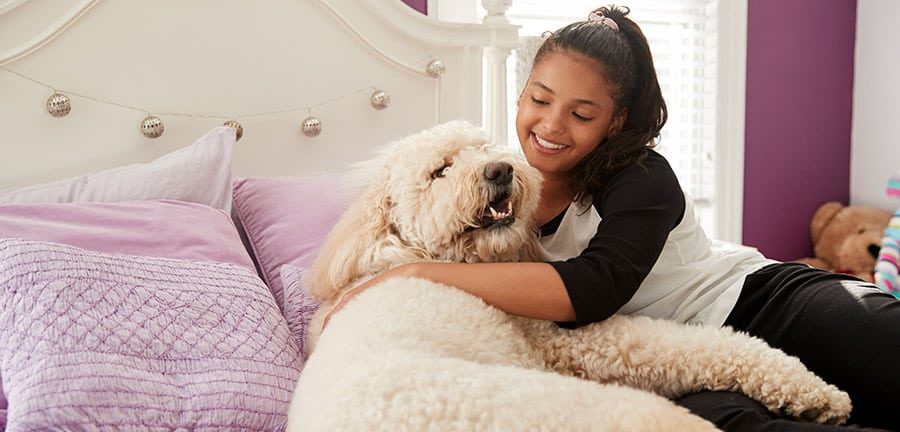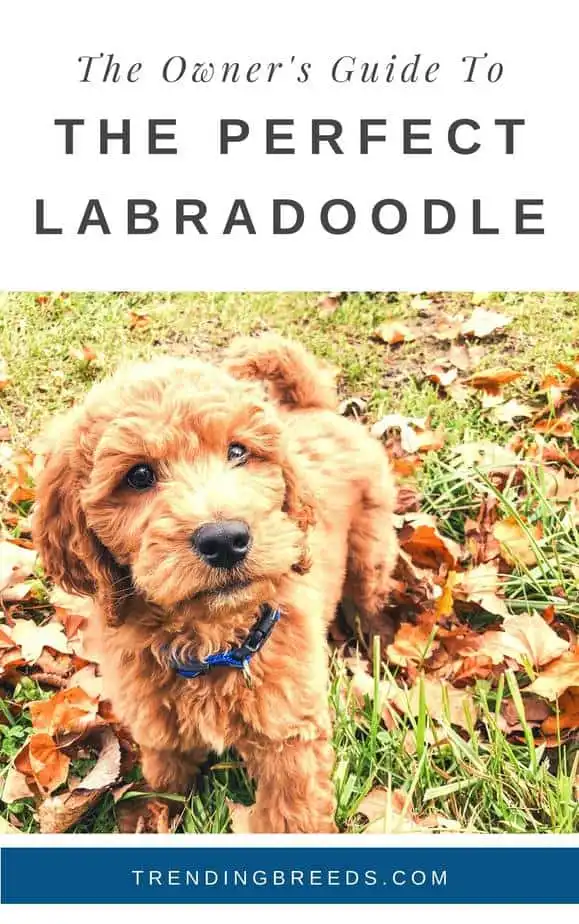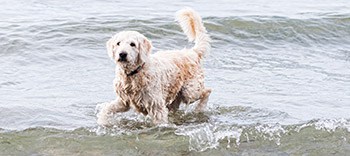
Do Labradoodles like to cuddle? Yes, for the most part; especially if they’re tired out from play. They are an extremely affectionate breed, love time with their people, and aim to please. But the degree to which a Labradoodle likes to cuddle may depend on their specific personality, their stage in life, level of tiredness, and even the temperature.
You know, it’s hard to answer questions like this with a very definitive answer. It’s like asking ’do kids like pizza?’. While the vast majority of kids indeed like pizza, some don’t, some only like it with cheese, and some might not like it until they’re ten years old.
Labradoodles, with that teddy bear appearance, just look like they’d be cuddling machines. But that’s not always the case. Below are some factors that come into play when looking at how much they want to cuddle.
Quick Tip: A tired pup is much more likely to want to cuddle up with you. Here are some of our favorite toys, puzzles, and games that will do the trick!
Energy Level
As a pup, I noticed that Oliver was way more apt to cuddle up next to us after some running around and tiring him out. This shouldn’t come as a surprise. Exercise is a dog owner’s best friend when it comes to getting a pup to cooperate and relax…just as it is with kids! We’ve included some of our favorite exercises and how much activity they need in this simple guide.
Age And Stage Of Life
The first 12 to 18 months of a dog’s life bring a ton of change (and challenge for the owner).
- 2 to 4 months: At this age, you’ll notice your Labradoodle puppy’s desire to be close is at an all-time high. They don’t want you to leave their side and are usually up for cuddling often. At this age, they get tired out pretty quickly, so you should have plenty of opportunities to cuddle. Make sure you take advantage of it.
- 4 to 6 months: Prepare yourself for increased independence during the ‘pre-adolescent period’. Your pup will have a greater drive to explore and experience the world on their own. They’ll be more and more comfortable leaving your side.
- 6 to 12 months: As their attention span reduces, their going to be seeking more stimulation during this stage. So cuddling might not be the most stimulating activity. You might need to lure them with their favorite bone or toy to get them to stay close.
- 12+ months: This is where your pup starts to become a dog. They begin to settle into the animal they’ll ultimately be. As they get older (most) dogs tend to mellow out and enjoy relaxation. So you should see much more cuddling and affection through the next coming years.
As an owner of 2 Labradoodles myself, I know how tough it can be to find good information. In the 60+ pages of this book, I share the information, resources, and breed-specific tips I wish I’d had from the start. You will save you time, money, and loads of frustration…take my word for it!
Claustrophobia And Confined Areas
Like humans, dogs too can become claustrophobic and react negatively to confined spaces. While this is usually seen with dogs when they’re placed in a carrier or crate, it can also be triggered my close cuddling. If you notice your pup experiencing any of these symptoms, you might want to back off and give them some space:
- Whining – this can also be whimpering, moaning, barking, or even howling.
- Panting – brought on by the stress they’re feeling, panting (when it’s not hot and they aren’t overexerted) is a clear signal that your pup is uncomfortable.
- Trembling – while not usually seen unless the dog is in an extreme amount of distress, shaking or trembling is an indication of real fear.
Temperature
“I am gettin’ so hot, I…” don’t wanna cuddle with you! Ok, that’s not how the song goes. But I feel like Labradoodles are probably singing that sometimes when their people are trying to force them to cuddle with them. Depending on the temperature, it’s quite possible that they’re just too hot to be close to you, especially if you’re keeping her coat a little bit longer (like we do).
Tips For Getting Your Labradoodle To Like Cuddling
We’ve stressed previously the importance of exposing your pup to all kinds of new things when they’re young. One thing we talked about was getting them used to touch by touching their paws, ears, mouth. Not only does this get them ready for trips to the groomer and vet visits, it also gets them used to your touch and closeness. But there’s more you can do to increase the chances your Labradoodle is a cuddler.
- As a puppy, make it a habit to bring them on your lap for some relaxation time. You’ll have better success with this if they’re well-exercised and tired out.
- Make sure they’ve had enough mental stimulation as they’ll be more likely to curl up and relax. Here are some of our favorite mental exercises and tips.
- Rub their head, back, and arms. Talk in a calming voice.
- Start with short periods of time. Remember, as a puppy gets older (6 to 12 months especially), their attention span reduces. Gradually increase the length of these cuddle sessions.
- Don’t force the situation. If you can see they are losing interested, cuddling is over. Try your best to end on a good note, before they get super squirmy and run away.
- With some patience and time, your pup will begin looking forward to that time with you. They might even start seeking you out when they’re ready to relax and hang out.
As a pup, our Oliver was really funny when it came to cuddling and relaxing with us. As the night wound down, we’d scoop him up and bring him to the couch to lay by us. A lot of the time, he’d lay there for 30-40 minutes…pop up…jump to the floor and go to the kitchen to lay on the hard floor. I never understood why he’d choose the hard floor over the soft, fluffy couch. But he did. Just remember that all pups are not the same. Don’t take it personally if they don’t want to be close to you when you want them to.
Related Questions
Are Labradoodles affectionate?
Labradoodles are known for being a very affectionate, cheerful, sociable, and all-around friendly breed. This mix of traits, along with their confidence without aggression, makes them a sought-after family and service dog. It’s important they learn to manage their excessive friendliness from a young age as it may be off-putting to other more timid dogs or humans.
Are Labradoodles soft?
There are 3 different coat types seen in Labradoodles: Hair, Fleece, and Wool. While they are all soft to a certain degree, the Fleece coat is by far the softest. It’s also the most popular coat and the one people typically associate with Labradoodles.
That’s All Folks
While it’s hard to guarantee a Labradoodle will be the ultimate cuddle companion, it’s a sure bet they’ll be a joy to have around. And if you do a good job getting them used to relaxing by your side, and do your part to keep them well exercised, I’m sure you’ll find they really look forward to cuddling up when they’re ready to settle down. They really are a great companion dog.





